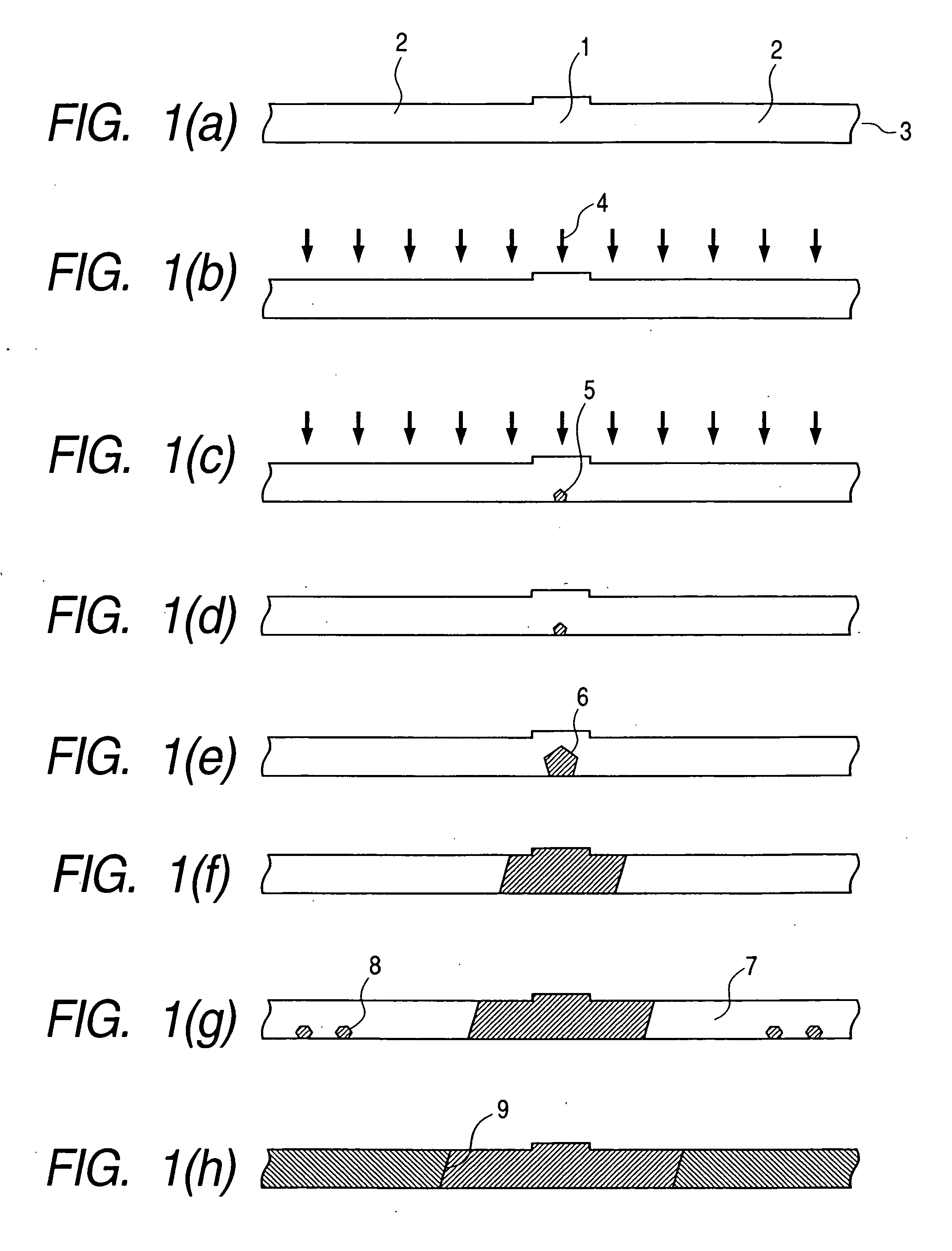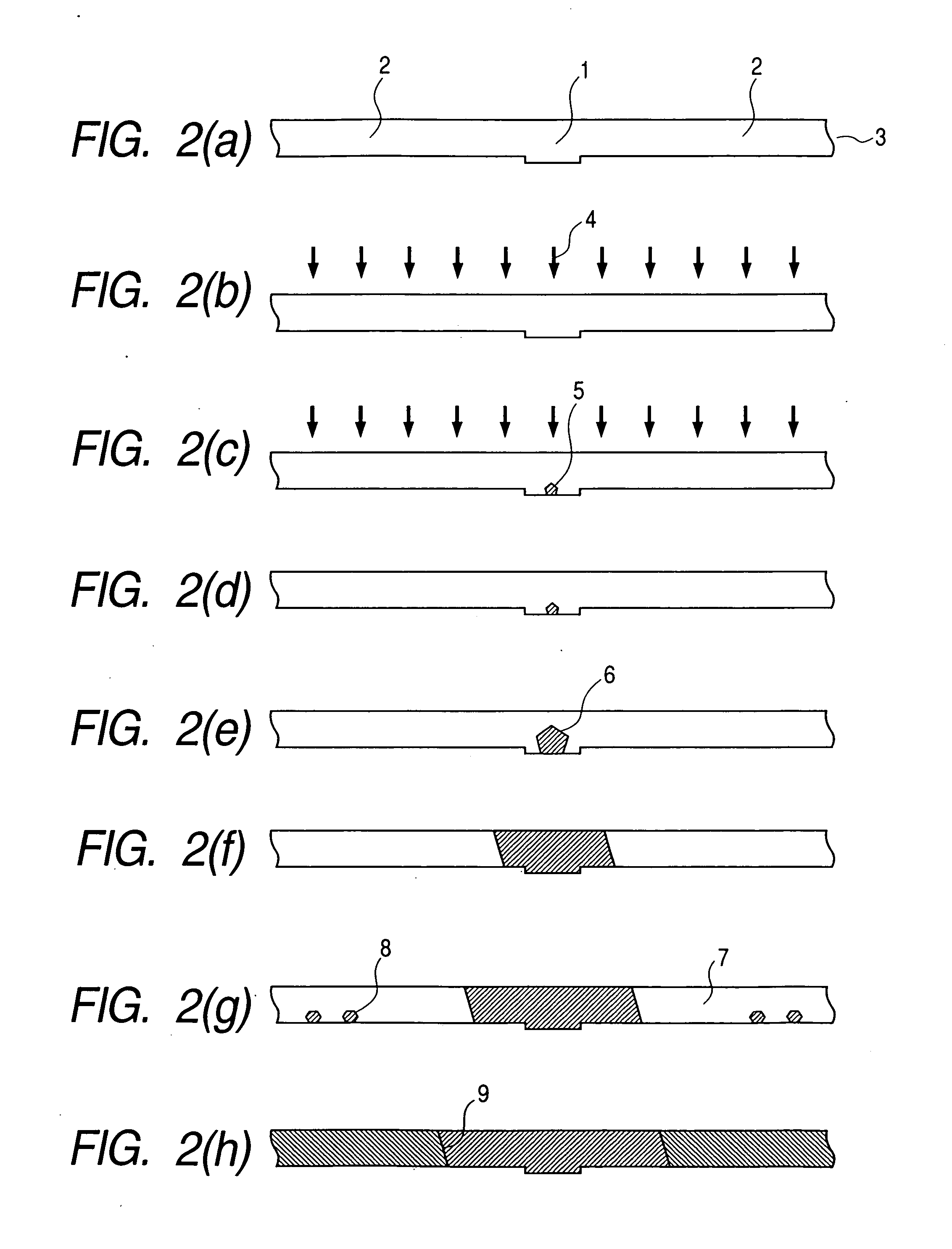Producing method for crystalline thin film
a technology of crystalline silicon film and production method, which is applied in the direction of crystal growth process, polycrystalline material growth, chemistry apparatus and processes, etc., can solve the problems of insufficient performance of thin film transistors utilizing current melted and resolidified polycrystalline film for the next generation liquid crystal display of widescreen or high-definition, deficient performance of polycrystalline silicon film, and inability to provide such high-performance devices
- Summary
- Abstract
- Description
- Claims
- Application Information
AI Technical Summary
Benefits of technology
Problems solved by technology
Method used
Image
Examples
example 1-1
[0169] This Example shows an example of a crystalline silicon film formed by the process of the present invention shown in FIGS. 1(a) to 1(h).
[0170] First, on a substrate (not shown) having an amorphous surface containing silicon oxide etc., an amorphous silicon film 3 of a thickness of 55 nm is formed by vapor phase deposition. Then, by dry etching, the amorphous silicon film is removed by 5 nm from the surface, except for a small region 1 of a diameter of about 1 μm in the plane of the amorphous silicon film. Thus the region 1 of a diameter of about 1 μm has a thickness of 55 nm and the other region 2 has a thickness of 50 nm.
[0171] Then, the starting film is irradiated with a KrF excimer laser light 4 for 30 nsec with an energy density of about 240 mJ / cm2 to melt the starting film, and the film was resolidified to obtain a crystalline film.
[0172] When the crystal grain shape constituting the obtained crystalline film is observed, a single crystal grain of a diameter of about 2...
example 1-2
[0177] This Example shows a crystalline silicon film formed by the process shown in FIGS. 2(a) to 2(h).
[0178] First, a substrate (not shown) containing silicon oxide etc. and having an amorphous surface is processed to form on the surface a cylindrical crater of about 0.5 μm in diameter and 10 nm in depth by dry etching. Then, an amorphous silicon film 3 of a thickness of 100 nm is formed on the substrate surface by vapor phase deposition. A cross section of the amorphous silicon film is 105 nm thick at the center of a region 1 of about 0.5 μm in diameter, and 100 nm thick in the region 2 other than the region 1.
[0179] Then, the starting film 3 is irradiated with XeCl excimer laser light 4 for 40 nsec with an energy density of about 310 mJ / cm2 for melting and resolidification, to obtain a crystalline film.
[0180] When the crystal grain shape constituting the obtained crystalline film is observed, a single crystal grain reaching a diameter of 3 μm grown from the small region of the...
example 1-3
[0184] As a third example of the present invention, there is shown a crystalline silicon film formed by steps shown in FIGS. 3(a) to 3(h).
[0185] First, on a substrate (not shown) having an amorphous surface of silicon oxide etc., an amorphous silicon film 3 of a thickness of 55 nm is formed by vapor phase deposition. Then, an etching-resistant masking material (not shown) is provided on the surface of a small region of a diameter of about 1.5 μm in the plane of the amorphous silicon film, and the amorphous silicon film is removed by wet etching by 5 nm from the surface. Thus, in the cross section of the amorphous silicon film 3, a region other than the small region 1 of a diameter of about 1.5 μm has a thickness of 50 nm, while the small region 1 of the diameter of about 1.5 μm has a thickness of 55 nm in a region of a diameter of about 0.7 μm at the center, and the thickness gradually decreases from the external periphery to the outside thus forming a truncated conical shape.
[018...
PUM
| Property | Measurement | Unit |
|---|---|---|
| thickness | aaaaa | aaaaa |
| diameter | aaaaa | aaaaa |
| diameter | aaaaa | aaaaa |
Abstract
Description
Claims
Application Information
 Login to View More
Login to View More - R&D
- Intellectual Property
- Life Sciences
- Materials
- Tech Scout
- Unparalleled Data Quality
- Higher Quality Content
- 60% Fewer Hallucinations
Browse by: Latest US Patents, China's latest patents, Technical Efficacy Thesaurus, Application Domain, Technology Topic, Popular Technical Reports.
© 2025 PatSnap. All rights reserved.Legal|Privacy policy|Modern Slavery Act Transparency Statement|Sitemap|About US| Contact US: help@patsnap.com



